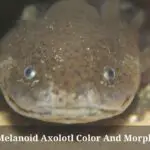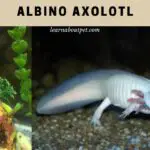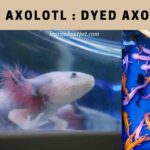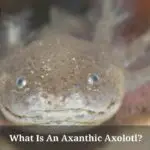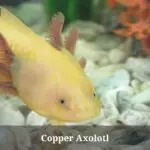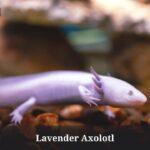Axolotls might be your most adorable aquatic pets. With their artistic gills, axolotls can become exotic pets that become the cutest pet you’ll ever have. What gets a lot of attention from aquatic pet owners is the variety of axolotl color types that make everyone want to own one.
Which axolotl colors are right for you? You need to know about five basic colors, including White Albino, Melanoid, Pink, Wild, and Golden. The color of axolotls is based on skin pigment. It is up to the owners to have what color is suitable for their aquatic pets.
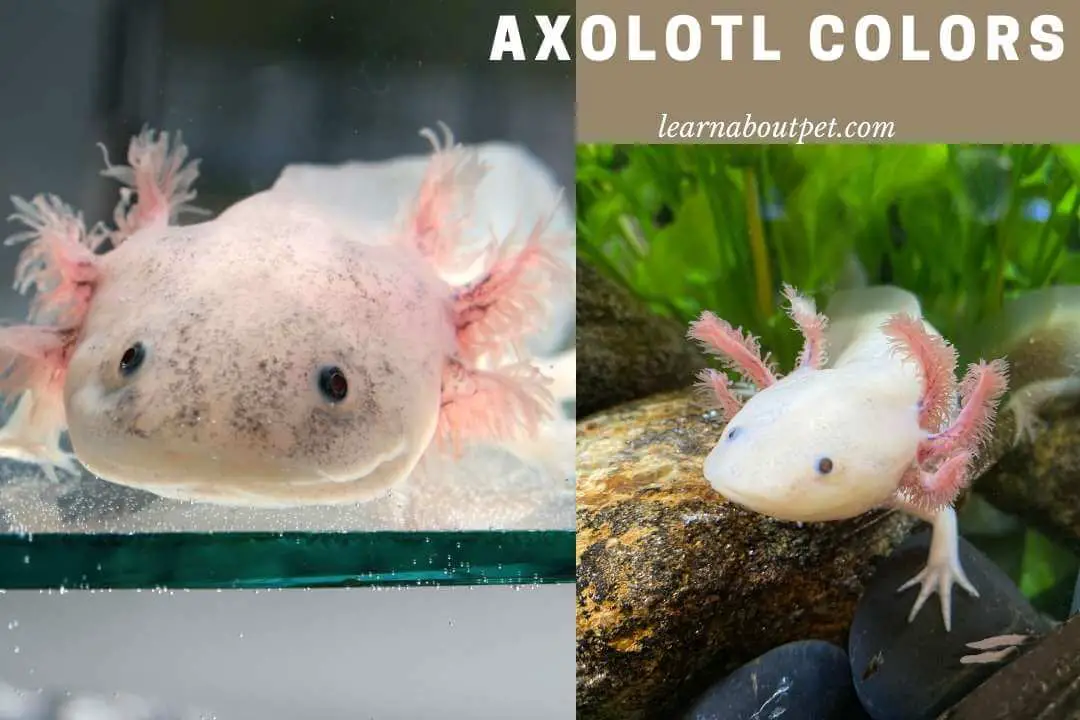
Apart from needing to know about the color of the axolotl, we also need to know about axolotl types. Let’s read this one until the end.
What Are All Axolotl Colors?
There are no fixed amounts to show how many axolotl colors are. If you find an axolotl in the wild, you can see a yellow axolotl or a tanned axolotl with a greenish undertone. But over time, you will see wild axolotls less and less as they become extinct.
When viewed from the five common colors such as wild, melanoid, leucistic, golden, and albino, there are many possibilities for the axolotl to have color variations from its genetics.
Because the variety of axolotls comes from the skin pigment, you are the one who has the right to determine which one is the most suitable for them.
What Is The Rarest Axolotl Colors?
The rarest breed of axolotl comes from the melanoid axolotl, that is, copper melanoid axolotl. The rarest color is Chimera, and it is debated whether the Chimera axolotl is a true morph or not.
Chimera also cannot be obtained from selective breeds because it comes from an accident of half wild and half albino.
Besides being very rare, Chimera is still ranked 11th among the more popular axolotl colors. Many aquatic pet owners prefer the second rank golden albino axolotl because it is cheaper and is common in all breeders.
How Many Axolotl Types Are Available?
There are more than 20 types of axolotls that can be owned as pets. But you will find it difficult to find all the available types because the axolotl is also an endangered species that is not widely available in aquatic pet stores.
Most axolotl types are obtained from genetic engineering lab results, giving rise to many morphs and mutant types.
While in pet stores, mutant types are more common than common axolotl colors such as melanoid or leucistic.
Rare Axolotl Colors
Owning a rare axolotl will be fun for aquatic pet owners. After all, apart from being difficult to get, you will be the center of attention from several axolotl owners because your axolotl is rare and rarely found in any breeders.
The table below will show some axolotl colors and types with their level of popularity and availability.
| Color / Type | Availability | Rank |
| Leucistic | Common | 1 |
| Golden Albino | Common | 2 |
| Wild | Common | 3 |
| Piebald | Rare | 4 |
| Mosaic | Very Rare | 5 |
| Copper | Uncommon | 6 |
| Lavender | Rare | 7 |
| Black Melanoid | Common | 8 |
| White Albino | Common | 9 |
| Chimera | Very Rare | 10 |
In the ranking above, there are already several rare axolotls that have entered popularity, although they are still difficult to get. Besides that, Enigma and Firefly are still at numbers 14 and 15, which people still don’t know much about.
Axolotl Basic Types
Basic morphs are a popular color and common option apart from the wild-type axolotl, evident in basic. The four other common basic morphs are leucistic, axanthic, albino, and melanoid. Let’s take a look at some basic morphs one by one with various possibilities.
Wild Type Axolotl
The wild colored axolotl you will often encounter in nature is very common among many aquatic salamander owners. This type has golden specks and darkish shades all over the body.
The dark shade of this axolotl colors comes from a combination of black, brown, and green. This color can help them hide from predators.
To distinguish wild-type from melanoids, wild has shiny specks of iridophores, the pigment cells of axolotls.
Leucistic Axolotl
Leucistic, pink, or lucy is a color combination of pink and white. You can see the gills has a baby pink color, and the body has a whiter shade. At first glance, you will be fooled and think of leucistic as an albino.
To differentiate between leucistic and albino, you can see from his eyes. Albino eyes are clear or red, while leucistic eyes are black.
Dirty Lucy Axolotl
These axolotl colors are not much different from leucistic, and only they have variations, namely the presence of freckles or black spots in their head or backs, such as dirty appearance.
The black dots or freckles help dirty lucy to hide from predators or other threats. In addition, these freckles are preferred by many aquatic pet owners because they seem artistic. In addition, the leucistic or lucy color itself is the most popular compared to other colors.
White Albino Axolotl
White albino or white axolotl has clear or red eyes. Even though it is a common color, this type is more difficult to find than Lucy.
The blood flow of this axolotl is visible due to a lack of color pigment. You will rarely see a white albino axolotl in the wild and still see a lucy axolotl more often.
If you have trouble distinguishing between leucistic and albino, you can see the gills and the eyes. In addition, there is no visible leucistic blood flow in his body.
Golden Axolotl
Axolotl gold is often known as a bright yellow color that attracts the attention of many aquatic pet owners. This type has the second most popular rank after leucistic.
The golden axolotl is also an albino with a yellowish body. Sometimes the gills follow the color of his body, and his eye color is clear or red. They can have dots or shiny stripes all over their body which is influenced by iridophores.
The beginning of this axolotl types is white albino and turns golden over time. You will be happy to see their change from white to gold.
Melanoid Axolotl
The full black melanoid axolotl is number eight in popularity ranking. This type is more similar to the wild-type axolotl but has no specks or dots on its body. Their body color is all pitch black because of the high quantity of melanophores.
Many axolotl owners put two opposite colors in one tank, namely axolotl black and white because it has a harmonious combination with opposite colors.
The black axolotl colors have black eyes, so you can hardly see them hiding in caves or aquariums without lights. This can be axolotl camouflage to avoid the threat.
Axolotl Uncommon Morphs
Next up are uncommon or special morphs, where these types are genetically engineered to be more striking and more mysterious. Even though it seems unusual, many axolotl lovers are still looking for these uncommon morphs because they are more unique and chosen to be their pets.
Although these axolotl colors are genetically modified, the lab ensures they can live a healthy life with the same lifespan as other axolotls, as this is a step to create a solution for regeneration and cancer.
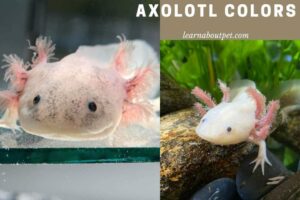
Axolotl Green
Green Fluorescent Protein is DNA in a lab setting known as axolotl green. It is a recessive green that can be passed down to the next generation. The protein can make axolotls appear green under blue lighting or UV light. If the axolotl has less pigment, the green color will be more visible.
Any axolotl morphs can become GFP axolotls and are categorized as special morphs because they have this gene. Now you can get axolotl GFP in any breeder. This means that all axolotl colors can appear green when there is blue lighting in your tank if you have the GFP gene.
Do axolotls glow in the dark? It’s possible if your axolotl has the GFP gene and gets UV light from aquarium lights.
Copper Axolotl
The copper axolotl is also a special morph because it is a special type of albino. If the normal albino becomes golden or white, this special morph changes to tannish or copper. You will often see this type of axolotl in Australia, Germany, and the United States.
There are three axolotl colors in this type, copper, light copper, and het copper. Coppers do not have melanophores, although they can have dark spots on their bodies.
If there are dark spots on their body, it can be categorized as a copper melanoid axolotl which is the rarest breed and very difficult to get as pets.
Axolotl Rare Morphs
Rare morphs are some axolotls that you have to get by spending more money because you will very rarely find them in breeders. Although almost unobtainable, you will feel happy if you find one and become your pet. Let’s take a look at some rare axolotl morphs.
Chimera Axolotl
Chimera axolotls are a fuse of two eggs together by creating a split in the middle. Even because the two eggs are fused together, there is a possibility that one side of the body can develop more slowly than the other parts.
For the color, imagine half melanoid and half albino. It would be very interesting if you have axolotls with the color split right in the middle, even though their survivability is less than 0.1%. That’s why the axolotl chimera doesn’t exist.
Silver Dalmatian Axolotl
Silver Dalmatians have lavender and purple colors, or in the middle of the two. In addition, there are specks all over their body, so they look like Dalmatian dogs. You can find this type of axolotl in the United States, although it is very rare.
Piebald Axolotl
Piebald is often equated with dirty lucy, but there are some significant differences. Piebald has black spots all over its body with darker colors and bolder spots than dirty lucy. You can often find piebald axolotls in New Zealand with a rare level compared to dirty leucistic.
Mosaic Axolotl
The axolotl mosaic results from two DNA cells forming into one where each cell displays phenotypes of both parents.
The color of the mosaic axolotl for sale can vary because the color variations depend on the parents. Mosaic also cannot be reproduced from breeding because it is purely an accident during development.
Enigma Axolotl
Enigma has a base color on their body which is black, with a greenish pattern. You can find these axolotl colors from American hobbyists and only found in the United States.
Firefly Axolotl
Firefly emerged from embryonic graphing. The characteristics of the firefly are a dark body with a lighter tail or a light body with a darker tail. There is also a firefly with the GFP gene, so the lighter tail will look green after being exposed to UV light.
Final Verdict On Axolotl Colors
Axolotls are exotic pets that are adorable and interesting to own, especially if you know that there are so many color variations that you can choose from.

If you want to easily find axolotls in every breeder at low prices, you can look for leucistic or golden axolotls. Besides that, these two types of axolotls occupy the most popular axolotls.
There are three commonly known morphs: basic morphs, uncommon/special, and rare. Each morph has different characteristics and also different color variations.
Having an axolotl with a unique color certainly comes back to each owner’s preference because this is also from the axolotl’s skin pigment. If you want to get a rare or very rare axolotl, you have to pay more, because the amount and how to get it is also not easy.

Welcome to Learn About Pet. My name is Rajkumar Ravichandran and I love all pets, travel, and amazing food. I write about my passion and personal experience caring for multiple pets in this blog! ❤️
Post Disclaimer
DISCLAIMER: THIS BLOG OR WEBSITE, "Learn About Pet", DOES NOT PROVIDE YOU WITH MEDICAL ADVICE AND IS NOT A SUBSTITUTE FOR MEDICAL ADVICE. ALWAYS GET IN TOUCH WITH YOUR PERSONAL VETERINARIAN AND USE INFORMATION HERE AS GENERAL ADVICE.
The information, including but not limited to, text, graphics, images and other material contained on this website are for informational purposes only. No material on this site is intended to be a substitute for professional veterinary advice, food recommendation, diagnosis, or treatment. Always seek the advice of your veterinarian or other qualified health care provider with any questions you may have regarding a medical condition or for pet food related questions.
